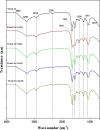Biosorption of nickel, cobalt, zinc and copper ions by Serratia marcescens strain 16 in mono and multimetallic systems
- PMID: 34657229
- PMCID: PMC8803796
- DOI: 10.1007/s10532-021-09964-9
Biosorption of nickel, cobalt, zinc and copper ions by Serratia marcescens strain 16 in mono and multimetallic systems
Abstract
The metallurgical industry is one of the main sources of heavy metal pollution, which represents a severe threat to life. Metals can be removed from aqueous solutions by using microbial biomasses. This paper analyses the heavy metal biosorption capacity of Serratia marcescens strain 16 in single and multimetallic systems. The results obtained show that Co(II), Ni(II) and Zn(II) biosorption in monometallic systems is two to three times higher than in the presence of bi-metallic and multimetallic solutions. Fourier transform infrared spectroscopy confirmed that carbonyl, carboxyl and hydroxyl were the main functional groups, as well as the amide bands I and II involved in metal uptake, which are present in external structures of the bacterial cell. The results obtained demonstrated the viability of S. marcescens strain 16 as a biosorbent for the design of eco-friendly technologies for the treatment of waste liquor.
Keywords: Biosorption; Heavy metals; Multimetallic systems; Serratia marcescens; Waste liquor (WL).
© 2021. The Author(s).
Figures






Similar articles
-
Optimization of nickel and cobalt biosorption by native Serratia marcescens strains isolated from serpentine deposits using response surface methodology.Environ Monit Assess. 2022 Feb 10;194(3):167. doi: 10.1007/s10661-022-09816-w. Environ Monit Assess. 2022. PMID: 35142917 Free PMC article.
-
Biosorption of copper, zinc, cadmium and chromium ions from aqueous solution by natural foxtail millet shell.Ecotoxicol Environ Saf. 2018 Dec 15;165:61-69. doi: 10.1016/j.ecoenv.2018.08.084. Epub 2018 Sep 4. Ecotoxicol Environ Saf. 2018. PMID: 30193165
-
Biosorptive application of defatted Laurus nobilis leaves as a waste material for treatment of water contaminated with heavy metal.Int J Phytoremediation. 2019;21(6):556-563. doi: 10.1080/15226514.2018.1537254. Epub 2019 Feb 7. Int J Phytoremediation. 2019. PMID: 30729808
-
Fungal biosorption--an alternative to meet the challenges of heavy metal pollution in aqueous solutions.Environ Technol. 2011 Apr;32(5-6):467-91. doi: 10.1080/09593330.2011.572922. Environ Technol. 2011. PMID: 21877528 Review.
-
Biosorption with algae: a statistical review.Crit Rev Biotechnol. 2006 Oct-Dec;26(4):223-35. doi: 10.1080/07388550600972153. Crit Rev Biotechnol. 2006. PMID: 17095433 Review.
Cited by
-
Removing Heavy Metals: Cutting-Edge Strategies and Advancements in Biosorption Technology.Materials (Basel). 2024 Mar 1;17(5):1155. doi: 10.3390/ma17051155. Materials (Basel). 2024. PMID: 38473626 Free PMC article. Review.
-
A mini-review on indigenous microbial biofilm from various wastewater for heavy-metal removal - new trends.World J Microbiol Biotechnol. 2023 Sep 16;39(11):309. doi: 10.1007/s11274-023-03762-6. World J Microbiol Biotechnol. 2023. PMID: 37715865 Review.
-
Comparative genomic analysis of metal-tolerant bacteria reveals significant differences in metal adaptation strategies.Microbiol Spectr. 2025 Jun 3;13(6):e0168024. doi: 10.1128/spectrum.01680-24. Epub 2025 Apr 24. Microbiol Spectr. 2025. PMID: 40272196 Free PMC article.
-
Bioremediation of heavy metals polluted environment and decolourization of black liquor using microbial biofilms.Mol Biol Rep. 2023 May;50(5):3985-3997. doi: 10.1007/s11033-023-08334-3. Epub 2023 Feb 25. Mol Biol Rep. 2023. PMID: 36840848
-
Finding the best combination of autochthonous microorganisms with the most effective biosorption ability for heavy metals removal from wastewater.Front Microbiol. 2022 Oct 6;13:1017372. doi: 10.3389/fmicb.2022.1017372. eCollection 2022. Front Microbiol. 2022. PMID: 36267171 Free PMC article.
References
-
- Cayllahua JEB, Torem ML. Biosorption of aluminum ions onto Rhodococcus opacus from wastewaters. Chem Eng J. 2010;161:1–8. doi: 10.1016/j.cej.2010.03.025. - DOI
Publication types
MeSH terms
Substances
LinkOut - more resources
Full Text Sources

